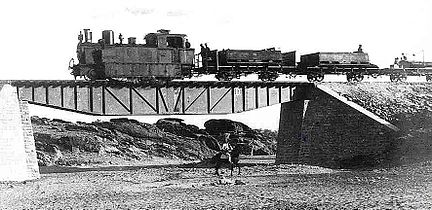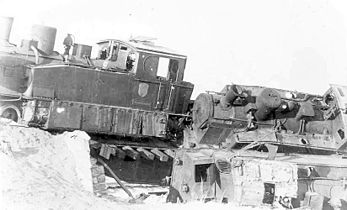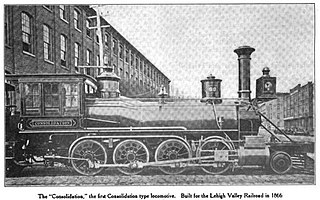
Under the Whyte notation for the classification of steam locomotives, 2-8-0 represents the wheel arrangement of two leading wheels on one axle, usually in a leading truck, eight powered and coupled driving wheels on four axles, and no trailing wheels. In the United States and elsewhere, this wheel arrangement is commonly known as a Consolidation, after the Lehigh and Mahanoy Railroad’s Consolidation, the name of the first 2-8-0.

Under the Whyte notation for the classification of steam locomotives, 0-10-0 represents the wheel arrangement of no leading wheels, ten powered and coupled driving wheels on five axles and no trailing wheels. In the United Kingdom, this type is known as a Decapod, a name which is applied to 2-10-0 types in the United States. In the United States, the type is known as ten-coupled.
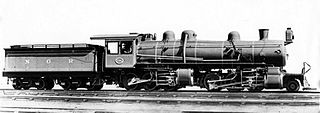
Under the Whyte notation for the classification of steam locomotives by wheel arrangement, 2-6-6-0 is a locomotive with one pair of unpowered leading wheels, followed by two sets of three pairs of powered driving wheels and no trailing wheels. The wheel arrangement was principally used on Mallet-type articulated locomotives. Some tank locomotive examples were also built, for which various suffixes to indicate the type of tank would be added to the wheel arrangement, for example 2-6-6-0T for an engine with side-tanks.
A compound locomotive is a steam locomotive which is powered by a compound engine, a type of steam engine where steam is expanded in two or more stages. The locomotive was only one application of compounding. Two and three stages were used in ships, for example.
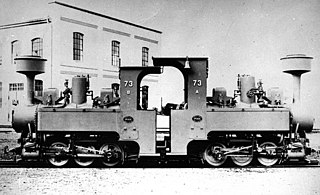
The South West African Zwillinge 0-6-0T of 1898 was a narrow gauge steam locomotive from the German South West Africa era.
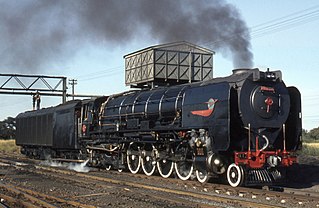
The South African Railways Class 25 4-8-4 of 1953 was a condensing steam locomotive.

The South African Railways Class 24 2-8-4 of 1949 is a steam locomotive.

The South African Railways Class Experimental 1 4-6-2 of 1907 was a steam locomotive from the pre-Union era in the Cape of Good Hope.

The South African Railways Class Experimental 2 2-8-0 of 1902 was a steam locomotive from the pre-Union era in the Cape of Good Hope.

The South African Railways Class Experimental 3 2-8-0 of 1903 was a steam locomotive from the pre-Union era in the Cape of Good Hope.

The South African Railways Class MA 2-6-6-0 of 1909 was a steam locomotive from the pre-Union era in the Natal Colony.

The South African Railways Class MB 2-6-6-0 of 1910 was a articulated steam locomotive from the pre-Union era in the Colony of Natal.
The South African Railways Class MC 2-6-6-0 of 1912 was a steam locomotive.

The South African Railways Class MD 2-6-6-2 of 1910 was a steam locomotive from the pre-Union era in Transvaal.
The South African Railways Class ME 2-6-6-2 of 1912 was a steam locomotive.

The South African Railways Class MF 2-6-6-2 of 1911 was a steam locomotive from the pre-Union era in Transvaal.
The South African Railways Class MG 2-6-6-2 of 1911 was a steam locomotive from the pre-Union era in Transvaal.

The Central South African Railways Rack 4-6-4RT of 1905 was a South African steam locomotive from the pre-Union era in Transvaal Colony.

The South West African 2-8-0 of 1911 was a steam locomotive from the German South West Africa era.
The Cape Government Railways 4th Class 4-6-0TT of 1882 with Joy valve gear, was a South African steam locomotive from the pre-Union era in the Cape of Good Hope.


